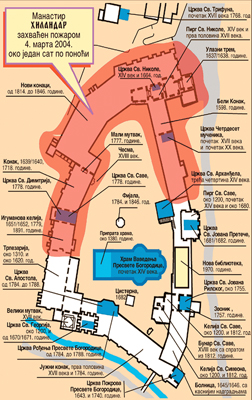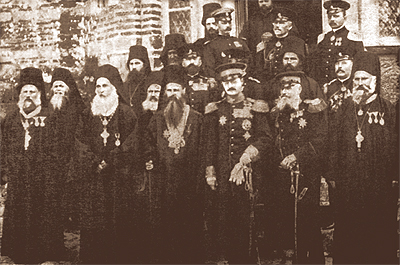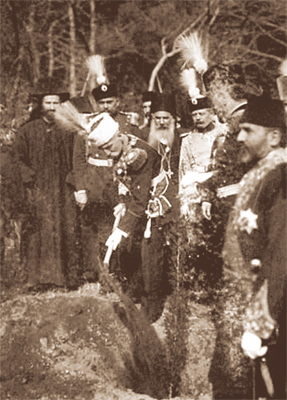Pilgrimage
HOLY MOUNT PATHS (3): HILANDAR, THE “SCALES OF SERBIA” AND THE “BAROMETER OF THE SOUL”
Fire of Purgation and Atonement
Was the fire which entangled the Serbian imperial Laura in the Holy Mount of Athos in March 2004 the same one that rages in our fatherland for years, taking away the people and holy relics, countries and centuries? The holy monastery, as a spiritual foundation of the Serbian nation, from its beginning, shared the faith of fatherland. As it used to be, it is so now
By: Мišo Vujović
 When the Serbian medieval state was most powerful, Hilandar had over 30 land properties, 360 villages, big real estates, hundreds of acres of woods, meadows, farming land… The Serbian imperial Laura, by its wealth, could be compared to a smaller state. The Holy Bishop Nikolaj did not accidentally write that Hilandar is the scales of Serbia. The destiny of the fatherland, for centuries, as it is the case today, was shared by the holy monastery as a spiritual foundation of the Serbian nation. When the fire came, in the begging of March 2004, Metropolitan Amfilohije, on the charted remains of devastated quarters, said to the author of these lines: When the Serbian medieval state was most powerful, Hilandar had over 30 land properties, 360 villages, big real estates, hundreds of acres of woods, meadows, farming land… The Serbian imperial Laura, by its wealth, could be compared to a smaller state. The Holy Bishop Nikolaj did not accidentally write that Hilandar is the scales of Serbia. The destiny of the fatherland, for centuries, as it is the case today, was shared by the holy monastery as a spiritual foundation of the Serbian nation. When the fire came, in the begging of March 2004, Metropolitan Amfilohije, on the charted remains of devastated quarters, said to the author of these lines:
“We did not expect that fires, for years now raging in fatherland, taking away people and holy relicts, shall entangle Hilandar, as well. It is obvious that the flame, traveling on a mysterious road, as God’s sign, came to Hilandar. We hope that here, that fire shall be the fire of purgation, renewal and atonement. The fire of change. Hilandar as the barometer of the soul, participating with this great cavalry in the suffering of its people…”
 The Turkish conquests did not spare any of the monastic states in the world. The Holy Mount temporarily fell under the Turkish rule around 1403, only to be in constant slavery from 1430 until 1912. Hilandar shares the destiny of the Holy Mount monasteries, which defend themselves from the slavery with their only weapon – rising of prayers and atonement towards God and the Holy Mother of God, Protector of the Holy Mount. The Turkish conquests did not spare any of the monastic states in the world. The Holy Mount temporarily fell under the Turkish rule around 1403, only to be in constant slavery from 1430 until 1912. Hilandar shares the destiny of the Holy Mount monasteries, which defend themselves from the slavery with their only weapon – rising of prayers and atonement towards God and the Holy Mother of God, Protector of the Holy Mount.
Sultan Orhan encroached all of the assets of the Holy Mount monasteries with his decree. Conquerors carried away from the pleasance of the Holy Mother of God many valuable relics. During the Turkish rule on the Holy Mount, Hilandar monks visited Orthodox nations, reaching even Russia. Russian imperators, led by Ivan the Terrible, helped the Serbian people. In 1556 Hilandar gets Podvorje, as a gift, in Moscow.
Together with Turkish crimes, plunder, robberies, racketeering, murders, there were other misfortunes. In the year of 1722, during the great fire, the old monastery library vanished. The fire swallowed everything from the tower of Saint Sava to the tower of Saint George. Monks’ premises were turned to ashes. Serbia was also burned down during that time, devastated, people in processions fled from one slavery to the other.
The Diocese of Karlovac rushed to help Hilandar. Archbishop Vićentije Popović gathered help. Four years later another fire, of less proportion, entangled the monastery’s dining room. Parts of the frescoes made by Georgije Mitrofanović were destroyed. Hilandarians didn’t surrender. They build, renew, and paint.
In the fatherland, the Turks burn old manuscripts. In Vračar, they burn relics of the first Serbian educator. The memory was intensively erased, title deeds were destroyed, roots were burning… With the forceful abolition of the Patriarchate of Peć came huge migrations. By the beginning of the 17th century, there were eight hundred monks in Hilandar.
Hilandar “black-robes”, didn’t get weary in their noble deeds and prayer. They build and repair. Prudently they net Christ’s wreath, despite the harm of rugged Agaryans.
“And in futile days of nation upheaval”, as Rakić sings to Jefimija, whose golden embroidery and silver thread was a present to the monastery, where it is kept even today, Hilandarians, in the spirit of this message by Despot Stefan “they knit their song”.
THE WORSE TIMES SINCE THE GENESIS
 The monk Đorđe Mitrofanović renews the painting in the monastery’s dining room. Saints glow from ancient walls, breaking the darkness of slavery. With the fall of the Serbian state in Turkish slavery, begins the long period of separation between Hilandar and its home country. At the time of Sultan Abdul Abuda, at the end of the 18th century, Hilandar became the Turkish army outpost, as the border monastery. Many monks left the monastery because of that. With the breakthrough of Bulgarians, comes a period of great insolvency and spiritual crisis. Broken ties with the home country brought many troubles. The Bulgarians overtook the managing of the monastery, relentlessly spending the fortune left after Turkish depredation. Some Bulgarian monks were engaged in usury and lone sharking, on which traces were left in monastery achieves. The monk Đorđe Mitrofanović renews the painting in the monastery’s dining room. Saints glow from ancient walls, breaking the darkness of slavery. With the fall of the Serbian state in Turkish slavery, begins the long period of separation between Hilandar and its home country. At the time of Sultan Abdul Abuda, at the end of the 18th century, Hilandar became the Turkish army outpost, as the border monastery. Many monks left the monastery because of that. With the breakthrough of Bulgarians, comes a period of great insolvency and spiritual crisis. Broken ties with the home country brought many troubles. The Bulgarians overtook the managing of the monastery, relentlessly spending the fortune left after Turkish depredation. Some Bulgarian monks were engaged in usury and lone sharking, on which traces were left in monastery achieves.
Valuable manuscripts and relics vanished from the library and the treasury. The Russian Archimandrite Porfirije Uspenski, during his visit to Hilandar in 1845, “as a souvenir” has torn and took one page from “Miroslav’s Gospel”, a manuscript of priceless value.
In the 18th century, came a great change in ethnic structure of the monastery’s brotherhood. Dositej Obradović wrote in 1766 that “in the monastery, there is only a handful of Serbs, and the rest are Bulgarians who cannot make a deal whose monastery it is”. In 1859, Ljuba Nenadović found seventy Bulgarian monks and a couple of Macedonians. By the end of the 19th century, Dimitrije Avramović, the well known writer and a painter, testifies: “there are fifty monks in the monastery, barely a few Serbs among them”.
 Prince Miloš Obrenović started to renew ties between the home country and Hilandar in 1820, sending financial help to the monastery. Archimandrite Nićifor Dučić wrote that Miloš Obrenović protected Hilandar in 1821 in Istanbul from “the menace of the Turkish army”. Around 1840, Serbia sent 100,000 florins, with a promise of Prince Mihailo that “Serbia shall take care of Hilandar”. In the book entitles Hilandar in State Politics of Kingdom of Serbia and Yugoslavia, Radmila Radić quotes Sava Hilandarac: Prince Miloš Obrenović started to renew ties between the home country and Hilandar in 1820, sending financial help to the monastery. Archimandrite Nićifor Dučić wrote that Miloš Obrenović protected Hilandar in 1821 in Istanbul from “the menace of the Turkish army”. Around 1840, Serbia sent 100,000 florins, with a promise of Prince Mihailo that “Serbia shall take care of Hilandar”. In the book entitles Hilandar in State Politics of Kingdom of Serbia and Yugoslavia, Radmila Radić quotes Sava Hilandarac:
“With the help of Bulgarian money, the north part of the monastery was rebuilt. And if was not for Bulgarian generosity, the monastery would became Greek, because the misery was great and the future certainly hopeless.”
From this, we can see that not only Bulgarians had pretensions on Hilandar.
During slavery under the Turks, Hilandar monks often went to Serbia to beg. Prince Aleksandar Karađorđević forbid begging, replacing it with the help of 500 ducats.
During the 18th and the 19th century, Hilandar lived through maybe its hardest moments since its genesis.
SMALL TO THE SINFUL, GREAT IN FRONT OF GOD
In 1876, few Serbian monks sent their cry to King Milan Obrenović to get back the Serbian imperial Laura under the wing of the home country with his patronship. King Milan took Hilandar under his protection and, with Belgrade’s Metropolitan Mihailo, tried to give back the monastery to Serbian monks. Real disorder ruled the monastery, the one that brings to change of regime of living. Instead of community life prescribed by St. Sava`s Tipik * (set of church rules and regulations concerning life and service of monks) and rule of prior, they converted to idioritmic (hermit) life, and the management of the monastery was taken by epitrops.
Because of the idioritmic way of life, after the failed attempt to reestablish the community of living, negligence for monastery valuables, unworthy behavior for monks, trade, usury, wresting of common monastery valuables, by the might of the force, Hilandar became immensely indebted.
On 21st March 1896, King Aleksandar Obrenović arrived to Hilandar. Paying debts and bills, he returns Hilandar to the Serbian nation. King Aleksandar Obrenović, with the gift of Miroslav’s Gospel, becomes the second patron of the Serbian Holy Mount shrine. Hilandarians at halfway to arsana (mole) rose a drink fountain as ensign on sanative visit by King Aleksandar. Small in front of sinful human souls, big in front of God. It was written on the fountain:
 “The monument of King Aleksandar I, raised in honor of his arrival to the Serbian monastery Hilandar, where he was between from March 21st to March 25th 1896. This monument, surrounded by a vineyard and waterworks, was built, with the permission of Hilandar brotherhood, with multiple efforts Vasilije Hilandarac in 1902.” “The monument of King Aleksandar I, raised in honor of his arrival to the Serbian monastery Hilandar, where he was between from March 21st to March 25th 1896. This monument, surrounded by a vineyard and waterworks, was built, with the permission of Hilandar brotherhood, with multiple efforts Vasilije Hilandarac in 1902.”
Nevertheless, the struggle with the Bulgarian monks lasted few more years. Recently after the visit of King Aleksandar, as the Diocesan of Šabac Dimitrije wrote to the Minister of Foreign Affairs Aleksa S. Jovanović, “Bulgarian agitators manage to unsettle inconstant monastery brotherhood who expected rich gifts and help for the monastery from our state.”
The Bishop of Žiča, Sava, who came to Hilandar on October 21st 1897, was expelled from the monastery. It was written that in that time there was 83 monks, seven servants and six monks from other places in the monastery. From Serbia, there were seven monks, nine from Bulgaria, four Vlachs, one Russian, and three Czechs. Other monks were from the territories under the Turkish rule, mostly from Old Serbia and Macedonia, “poisoned by Bulgarian ideology.”
Cancellation of hospitability to Sava of Žiča provoked real revolt and anger in Serbia. Diocesan Melentija complains in his letter to Metropolitan Mihailo and states:
“Oh, I felt sick because of Hilandar. Oh, what a scandal, what a great cold-heartedness and dishonesty with those Bulgarians. And what we did for them! Let God judge them by the prayers of Saint Sava and Simeon. But we are also to be blamed. We would not hold on to and protect what is ours.”
***
Contract
The end of the writing mission of King Aleksandar Obrenović starts on March 30th 1900, with a contract made between the Kingdom of Serbia and Serbian Church on one side, and Hilandar, from the other side:
“The Council of Hilandar, with the entire brotherhood, was bonded to accept two monks from Serbia at the time. They shall take part in council procedures as monastery elders and participate as equals with others in “giving and taking”. Furthermore, they shall accept Serbs in monastery’s brotherhood, Serbs who would come to Hilandar to become monks and live there. Serbia is obliged to pay in full debt of monastery to the outside world, more than 5,000 Turkish liras, to give to the monastery an annual support of 1,000 liras, for those native monks shall not be expelled, except for the guilt that deserves prosecution. But if a monk, for any reason, wants to get out of the monastery by himself, the monastery is in that case obliged to give him the money that monk possesses, with interests on obligation. And the people from all over the world who came to the monastery to become monks and to live in the monastery, shall be received regardless the difference of their nationality.”
***
The 20th century
King Petar Karađorđević I asked to be crowned beside flag of Dušan, which came from the imperial Laura at Athos in 1903. The Hilandarians gave as a gift the icon of Saint Sava and Saint Simeon Mirotočivi to the new king.
It remains a mystery why King Alksandar Karađorđević never visited Hilandar. From the visit of his father to the visit of the next ruler of Serbia, Slobodan Milosević, in 1991, almost 90 years have passed.
***
Dangerous for the life of monks
After his post-graduate studies in Athens, Patriarch Gavrilo Dožić arrived in monastery Hilandar, where he was assigned as secretary in 1909. In the monastery archive, a little bit later, it was written that Archimandrite Gavrilo, annoyed with some wrong doing unworthy of a monk, performed by one of his brothers, assaulted him with his fist. In the protocol from the Council of Hilandar elders it was written – dangerous for the life of monks.
|
